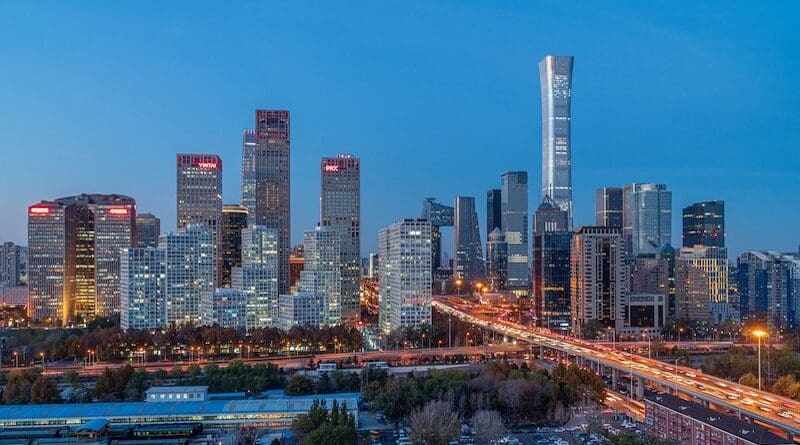Toward Coordinated Development In China – OpEd
In the past, industrialization and urbanization has left most advanced economies unbalanced. As evidenced by the “Jing-Jin-Ji” experiment, China seeks to move toward balanced and sustainable development.
After industrialization and urbanization, every advanced economy, to some degree, has coped with unbalanced, inadequate and uncoordinated development, including economic inequality and environmental damage.
What makes industrialization in China unique is its rapid growth and huge size – and hence the significant collateral damage. These negative spillovers cast a shadow over the broader Beijing-Tianjin-Hebei region, or “Jing-Jin-Ji” collectively. In early 2014, president Xi Jinping urged the megaregion to explore a sustainable development path that leverages complementary strengths and yields mutual benefits.
This year marks the 10th anniversary of the Jiang-Jin-Ji coordinated development strategy and the seventh anniversary of the establishment of the Xiong’an New Area, or the “city of the future,” in Hebei province.
Need for coordinated development
The Jing-Jin-Ji is the largest urban agglomeration and economic region in North China, with a population of 110 million people. The megaregion is pivotal to China’s north, just as the Yangtze River Delta region is to East China’s development and the Guangdong-Hong Kong-Macao Greater Bay Area is to South China’s development.
Beijing and Tianjin have advanced manufacturing capacity and strong tertiary sectors, whereas Hebei is less developed, as evidenced by its per capita income relative to Beijing (42%) and Tianjin (39%). Beijing has significant innovation capabilities, while Hebei offers relatively low-cost land and labor, which makes the strengths of the two places complementary.
Also, last year’s new plan aims to foster the growth of world-class industrial clusters in the megaregion, prioritizing electric vehicles, biopharmaceuticals, hydrogen energy, industrial internet, high-end industrial machinery, and robotics.
In the past decade, the Beijing-Tianjin-Hebei region’s investment has increased 2.1 times, accounting for more than 14 percent of the national total. Although the synergies have increased at county level, much potential remains to be tapped in regional synergies.
As for Xiong’an, the investment in the development of the “city of the future” will again exceed $28 billion this year. Over the past seven years, the “city of future” has emerged as a high-level modern showcase, with cutting-edge technologies such as 5G, big data, artificial intelligence and autonomous driving applied in the city.
Track-record so far
How has the Beijing-Tianjin-Hebei region fared in the past decade? The megaregion’s gross domestic product (GDP) reached about 1.4 trillion U.S. dollars in 2022, representing a 1.8-fold increase from 2013 in current prices. It now has over 11,000 kilometers of railways, up more than 30 percent in a decade, and nearly 11,000 kilometers of highways, up over 40 percent from 2013.
A more comprehensive assessment builds on the development index and indicators, such as innovation, coordination, green development, openness, and shared development. In this view, the megaregion has recorded a nearly 39 percent increase from 2014 to 2021.
Much remains to achieve, however. In addition to equity, other challenges include difficulties in the megaregion’s coordinated environmental governance, progress in the development of green and digital economies, and institutional mechanisms for coordinated development. Still, the early signs are promising, highlighting untapped potential.
When president Xi paid another visit to Xiong’an last year, he could not help but wonder about the huge progress since his first visit in 2017. “In just six years,” Xi said, “a highly modernized city rising from the ground is nothing short of miraculous.”
Challenges of regional differentiation in the West
Over a decade ago, I lectured in Shanghai Institutes for International Studies (SIIS) on national, regional and urban competitiveness, relative to international experiences. For years, I had cooperated with Harvard’s Michael Porter whose Competitive Advantage of Nations (1990) shifted international interest toward regional and urban clusters.
I recorded efforts to steer regional differentiation even in innovative small economies, including Finland’s Wireless Valley, Israel’s Silicon Wadi and Dublin’s tech hub. In EU, OECD and Nordic reports, I examined regional competitiveness in all major advanced and emerging economies, from the US to China, as well as regional high-tech clusters and megacities. In the America, China and India institute, I also saw how India sought to follow in China’s footprints in the future.
When worried me most in New York City was the dire state of urban slums, like Harlem and the Bronx. Worse, the devastated Rust Belt from New York through the Midwest, once the thriving center of manufacturing, was now synonymous with regions facing industrial decline and abandoned, rusty factories. To a few, it meant fabulous profits; to many ordinary Americans, it was a depressive nightmare.
But the more I spent time in China, the more I felt that Chinese development and the BRICs were shaking the old “rules of the game,” which in the past had been monopolized by the West.
Tough balancing act
In New York City, I saw successive city administrations trying to boost competitiveness, yet each US metropolis and state fought primarily for its own. In Europe, there is greater willingness at coordination, but the fragmented continent constrains integrated regional development.
Shunning coordinated regional development in the US has contributed to cutthroat competition. The net effect has been the “race to the bottom”; excessive deindustrialization and blind offshoring, which have hollowed out American industries, unleashing a host of employment, social and environmental challenges. Associated political challenges include protectionism, populism, and “America First” xenophobia.
What makes China’s regional strategies intriguing is the top-down effort to catalyze bottom-up initiatives, even though disparities in resources and development between the areas remain persistent.
During the first two terms of president Lula, Brazil managed to grow fast and reduce inequality, particularly in the poorer region and urban favelas. Indeed, economic development is about competition and cooperation. It is a tough balancing act to couple growth with equity, and both with sustainability.
A version of the commentary was published by China Daily on April 1, 2024

